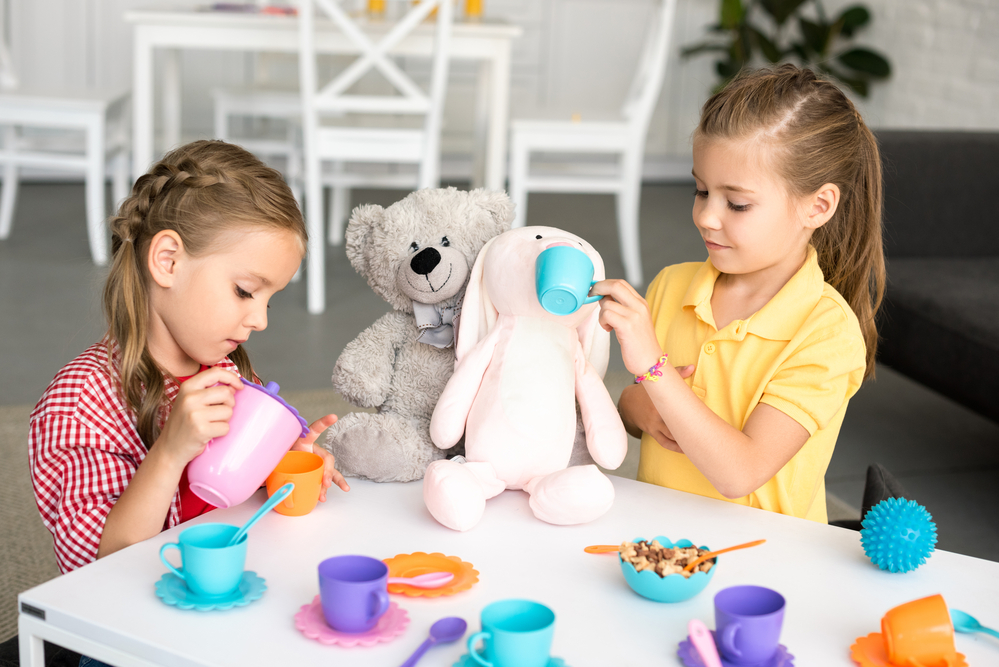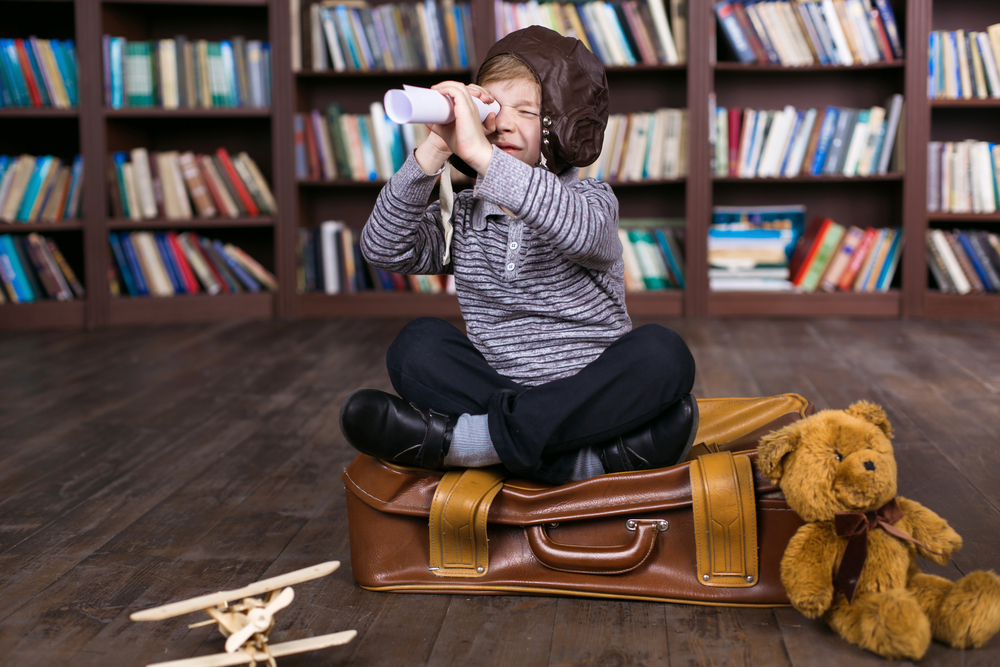Have you ever seen your child nurse their stuffed animals back to health? Or grab a lego to use as a steering wheel for a zooming car? These activities are some examples of pretend play.
While most people tend to view these actions as just fun and games with no real educational value, the more your child engages in pretend play, the more skills they build in many developmental areas.
In this article, we’ll look at what these specific developmental areas are, how you can create a home environment that encourages pretend play, and, most importantly, some ideas you can try at home with your child today!
What Is Pretend Play?

Pretend play has many different names, including:
- Make-believe
- Dramatic play
- Fantasy play
- Imaginative play
Whichever name you choose, these activities generally involve lots of role-playing or imitation, nonliteral behavior, and object substitution.
Children of different ages will display different levels of pretend play. Here’s a closer look at some of these phases.
18 To 24 Months
Most children start their pretend games somewhere between 18 and 24 months. During this time, they may act out real-life scenarios replicating activities they see parents, other family members, or caregivers do, such as stirring “soup” in a pot or talking on the phone.
24+ Months
From around 24 months, most toddlers start to display signs of symbolic thinking, in which one object can stand in for another. For instance, a stick will transform into a sword or a banana into a phone.
Around 3 Years
By age 3 or 4, children’s pretend play games will step up a notch as their imaginations and creative thinking continue to develop.
You might notice more elaborate dramatic play scenarios, such as superhero battles, pirate ship construction, and fairy castles.
3 To 5 Years
As children get older, the storylines will naturally become more extended and complex and involve a lot of acting. At this point, play will also involve more social skills as kids assign different roles to themselves and others.
Why Is Pretend Play Good For Children?

Now that we understand what pretend play is, it’s important to know its benefits for child development. Let’s take a look!
Helps Develop Thinking Skills
While engaging in make-believe play, children need to do a lot of problem-solving, like finding the right materials to create a spaceship or taking turns playing the same role.
As they get older and start involving their peers or family members in their games, pretend play requires children to develop an idea, consider other people’s perspectives, negotiate, and act out the idea.
All of this helps develop their cognitive skills.
Nurtures The Imagination

A significant part of pretend play involves make-believe, as the scenarios are often far-fetched from reality.
Fantasy worlds are created from empty boxes, old clothing, towels, blankets, and pretty much anything you have in or around your house. This requires lots of creativity and imagination to pull this off successfully!
Helps Develop Social And Emotional Skills
Social-emotional learning (SEL) is a gradual process that helps children and young people develop the ability to manage their emotions, work well with others and by themselves, feel empathy, and develop healthy identities.
Pretend play is an excellent way to help children continue developing these skills. For example, when kids pretend to be different characters, they have to put themselves in other people’s shoes.
If you have young children, then you know how kids can struggle to see the world from another person’s perspective! But as they take on different roles, they start learning to understand others’ feelings and develop empathy.
Cooperation And Conflict Resolution
As children get older and start involving others in their pretend play, they may need to take turns playing the same role or collectively come up with solutions to challenges.
While it may not be easy at first, the more practice they get, the more they will develop these essential skills.
Promotes Language Development

If you’ve ever eavesdropped on your child’s imaginative play, you may have been surprised by how many words and phrases they know.
Through pretend play, children get to practice the words and phrases they’ve heard. They may also start understanding the power of language, as they see that words help them communicate their thoughts and feelings.
Tips For Encouraging Pretend Play

Before we give you fun ideas to try out with your child at home, here are a few tips to make the most out of pretend play.
Let Your Child Lead
Sometimes parents make the mistake of trying to control make-believe play. We have our own ideas of what each activity should look like and how we want our kids to proceed.
However, it’s important to let kids have fun and not allow our own constraints to limit our children.
Incorporate Both Alone And Social Play
It’s important to encourage a mixture of playing alone and with family or friends. Both of these scenarios are key for children’s development.
Use Structured And Unstructured Play
Structured play is when you set up a specific scenario for your child or children and then allow them to act things out. With this type of play, you are hoping to help develop certain skills.
Unstructured play, on the other hand, is when children can choose their own fantastical worlds to immerse themselves in.
Both types of play help develop essential skills, so it’s very valuable to rotate between structured and unstructured play.
Finally, here are a few make-believe games your child will love!
7 Fun Pretend Play Ideas
1) Lights, Camera, Action!

There’s something special about going to the movies. The smell of popcorn, the tickets, the dimmed lights. Since everyday movie outings are unrealistic, why not bring the movies home?
First, start by encouraging your child to come up with a story. This story doesn’t have to be elaborate, and it doesn’t have to be completely new (a classic fairytale or superhero story will work!).
You can then use your child’s stuffed animals and toys as characters and help them take photos or videos of the scenes. Some apps also allow you to use the images to make a stop-motion film.
Finally, for movie premiere night, you can create posters of the movie, give away tickets to family members, and make some butter popcorn! Then sit back and enjoy the creation.
This is an excellent way to teach your child the many components of storytelling.
(If your child prefers a “live performance” over a movie, that is also fine. Curtain’s up!)
2) Cookie Bakery

If your child is like most kids, they probably love cookies. Help them see the process of creating those yummy treats by making a cookie bakery.
Help them create menus, dress up as a waiter, take orders from customers (family members), pretend to bake in the kitchen (or actually bake if you have the time!), and serve their goodies. You can even add a cashier to collect payment for the treats.
Feel free to use pretend cookies or grab some from the store for your child to “sell” if real baking isn’t an option that day.
3) Off To The Moon
Lots of exciting games come to fruition from simple, inexpensive items you may already have around the house.
For instance, an old cardboard box can be transformed into a rocket ship. To make this space vehicle, help your child cut out holes for windows, and then use crayons, colored paper, and other fun decorations to allow the vessel to come to life!
Creativity and imagination are just some of the skills your child will be working on with this activity.
4) Outdoor Hunt
If you want to get your child outside and take in some of that Vitamin D and fresh air, help them channel their inner explorer!
Start by hiding some of their toys in interesting places outside, like under your welcome mat, behind a tree, or by the flowers. They will then need to “rescue” the toys by going outside for a toy hunt.
You can add some more excitement by making it time-sensitive. For example, can they rescue all of their toy friends in 10 minutes?
5) Stuffed Animal Hotel

For this activity, fill a cardboard box with mailing tubes to represent each hotel room. Your child can then take on the role of the hotel manager and make sure every guest is happy during their stay.
Pure fun and entertainment are what you can expect from this fun activity!
6) Post Office Fun

Old-school snail mail is something special that your child can discover through pretend play. Start by using our Mail Adventure Kit. From it, you will get props including a Cotton Canvas Bag, envelopes, post office stickers, and more.
Using these items, encourage your child to set up their own post office, deliver mail, or even write some letters.
7) Construction Duties

There are lots of interesting construction sites your child might have seen you drive by in real life. With this activity, you can help them create their own.
The materials can include an old cardboard box as the construction site, toy tractors, building blocks, sand, rocks, and any other items that make sense for the space.
As the construction manager, your child will have plenty of work to do to ensure safety and that workers stay on schedule!
It’s Time To Play!

Pretend play is an excellent way for your child to continue learning about the world around them. They can use their imagination and creativity to create anything they want — the sky’s the limit.
For more fun ideas to help your child play while also learning and growing, check out our HOMER app!













